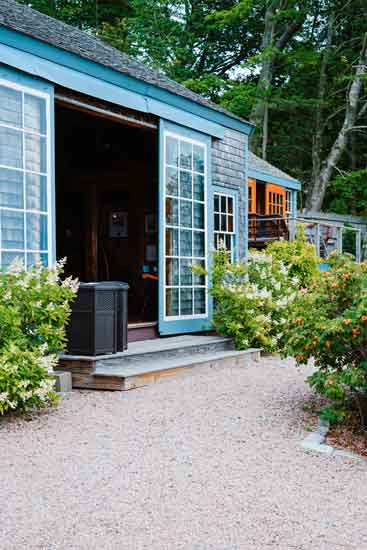
Doors are a foundation of our psyche. To understand this, we must ask ourselves: how do we move through doors, how do we conduct ourselves near doors, as we flit through our busy lives, bags in hand, lists in spirals in our minds, do we ever consider the door? Do we hesitate at the door, unsure whether to shake or hug or fall in love, do we wrench the heavy door and let it slam behind us, do we fiddle with the key every time? Do we listen through doors at the neighbors, do we try not to listen but hear anyway, do we know something through the door? We wait by doors for nervous encounters, for packages, for a dozen guests. Raised voices penetrate doors, or don’t. Doors hold our secrets, our bad habits. Doors hide abuse. In fights we slam doors, we lock ourselves behind doors, we leave through doors—we close or open intimacy with doors. Our psyche is a map of doors and, as such, doors are the manifestation of our inner borders.
As the materialization of emotional spaces, doors communicate intimacy. Bedroom doors affirm a sense of unspoken yet respected privacy. Behind bedroom doors is sex, is sleep. Behind bedroom doors we are naked. Doors are how we define naked spaces—are you naked in your room, in the kitchen, in the living room. If you have your own bedroom, the door is the boundary of your personal space. Open if you welcome visitors, closed if not. Inside is yours, do as you please. If you live with others, you have to adjust yourself as you cross beyond your door. How do you conduct yourself when you are outside of your door but still inside the door of your home?
A door is a structure of choices and dilemmas: open or closed, private or invited. It is used to divide space—inside, outside, mine, yours, locked or unlocked. They are made of metal, glass, wood; they hinge, slide, rotate; they are automatic or mechanically operated. Doors enclose space, allow entrance and exit, a boundary that may be crossed. The spaces we inhabit are quantified by doors: you are either indoors or outdoors. This means that when we think spatially about ourselves, it is in relation to doors—it is in intimacy with doors.
This intimacy goes both ways, a door is defined by its role in our lives. In other words, without us crossing a door’s frontier, a door is left meaningless. One classification: “A doorway is a portal between two STEMs (Space, Time, Energy and Matter intersections/encapsulations).” But a portal, like a door, is only relevant with a subject who moves from one STEM to another. And so, doors rely on us as much as we rely on them for meaning.
And what perfect material to articulate our most intimate feelings with. Or as Gaston Bachelard beautifully writes in The Poetics of Space: “How concrete everything becomes in the world of the spirit when an object, a mere door, can give images of hesitation, temptation, desire, security, welcome and respect. If one were to give an account of all the doors one has closed and opened, of all the doors one would like to re-open, one would have to tell the story of one’s entire life.” And this trail of doors behind us extents more than a single life-span. In fact, a 5,000-year-old door has been found by archaeologists in Switzerland, but the earliest doors in record are represented in paintings of ancient Egyptian tombs. There are paintings of single as well as double doors, all from a single piece of wood. These first doors shifted the ways humans interacted, kept out animals, strangers, the cold. Then they signified power and dominance. Privacy and accumulation. Doors were a vital step in shaping our psyche.
And now, we have entered the era of business and technology where doors are a function of capitalism. They are used to structure hierarchy: CEOs, assistants, secretaries, waiting rooms. They divide a shop from public space; throught this door, specialty leather wallets; through this door, the finest feather pillows. They establish power. An office with a door is significant compared to an office without a door. Privacy is granted to those with money and power. Without doors, how would we establish structure, systems, government? How would we build “civilization”? The idea of civilization itself is a function of doors, as “civilized” people live behind doors, but doors are an integral mechanism for colonial violence, exploitation, and environmental destruction.
Doors are involved in both shaping and challenging ideas of “civilization”. For instance, separate doors, usually in the back alley, have been allocated for people who were not deemed the ‘norm’: Black, Indigenous, racialized people, disabled people, women, hippies, the poor. As recently as 2014, low-income tenants in a London apartment building were told to use the ‘poor door’ as developers promised wealthy tenants that they would not have to share an entrance with those who lived in social housing. Doors are important in disability politics when fighting for accessibility in an ableist society, one that is designed for the able-bodied subject. This has shifted some doors to be larger and automatic, as well as approachable by a means other than stairs. In other words, doors uphold authority. Doors dictate who is welcome and who isn’t.
It is no coincidence that queerness is often dichotomized as in the closet or out. The closet can be a symbol of secrecy, privacy, non-acceptance in the public sphere, of oppression. But being out is not an exact antonym of in the closet. Out vs. in does not necessarily mean anything specific, it could be that one shows affection publicly or communicates ones sexuality to friends and family. Despite such nuances, the door remains a structure that communicates the multi-faceted world and intersections of what out means. It is a complex symbol of queer intimacy and liberation.
We can expose some inner workings of our humanity if we look closely at how we have manufactured our external landscape of doors. For instance, we like to organize space. We are continuously packaging air into rooms, homes, buildings. We like to move from air pocket to air pocket and we do that by going through doors. The full implications of 5,000 years of intimacy with doors are impossible to grasp.
With such a long standing affiliation, are our internal worlds somehow shaped by our intimacy with doors? Doors are embedded in our psyche, and since we often spatially conceive of our emotions with the understanding of open/closed, as well as in/out, doors must have a meaningful influence on our perceptions. We see ourselves as rooms with doors of communication, our inner worlds bound by our skin with connection and communication as the only exits. And as we become intimate with each other, on some level we feel as though we are walking through doors of connection. As Georg Simmel writes, “the human being is the connecting creature who must always separate and cannot connect without separating…And the human being is likewise the bordering creature who has no border.” Doors are a useful image in how we understand transcending such borders, as well as navigating connection and separation.
Despite such an influence, we do not think of doors often. How many doors do we touch in a day; do we really feel them? Do the doors we pass through really make an imprint on our memory? To understand the depths of our intimacy with doors, we must take note of the concrete. We must catalogue the relationship.
Observe: the indoors is a realm of spaces separated by doors; they swing, they shut, they slide, they creak. They distribute heat. In the bathroom, we close the door to relieve ourselves, change our clothing, look at ourselves in the mirror. We can be naked here, alone or together. We groom ourselves behind this door. We bathe, we brush, we moisturize. The privacy behind this door is understood. You do not open this door if you know someone is occupying the space behind it. Generally, if the mistake occurs, everyone involved is ashamed.

Outdoors is as much defined by doors. The city is endless rows of buildings with doors, homes with doors, shops with doors; cars, buses, trains, doors that hold you in while you move somewhere else. Doors line apartment building hallways, all numbered, all closed. We do errands, door-to-door, passing doors along the way, streets lined with doors. Inside these doors are spaces dedicated to a specific niche of product—clothing, cooking supplies, food and beverages, electronics. Other doors hold business offices, medical clinics, law firms, stairwells, custodial closets, and bathrooms on every floor.
And how many different doors have we encountered in our life-time, or more importantly, how many different types of doors have we invented? The most common type of door is the single-leaf door, which is classified by its single rigid panel that fills the doorway. A variation of this design is the double-leaf door or the French door. A louvred door has fixed or movable wooden fins (or slats), which enable ventilation while maintaining privacy and limiting the passage of light. In the dry Egyptian climate, where the first doors were made, wooden doors do not warp. However, elsewhere it is necessary to frame them and so panels are fit into the groves made in the stiles (the vertical boards) and rails (the horizontal).
A catalogue of the concrete manifestations of doors could be a map of intimacy. How we shape and move through our quantifiable world in some way turns inward and informs our inner architecture. Whether the door is made of wood or plywood may not have much to do with how we connect to each other and the world around us, but perhaps the weight of the door does subtly impede or encourage an excursion, and this, in some way, can influence how we feel.
I once had an intimate experience with a door. I hesitated, unsure if this was the door I was looking for. I saw its eggshell trim and held my breath. The door itself was also white but a distinctly different shade. It was perfectly flat and made of wood. The door nob was a light matte gold, round but with a sharpened edge. There was a small hole in its center. I paused before the door and felt that small tightening in your chest when you knock on a door for the first time. I inhaled, raised my arm, and curled my knuckles. I brought my knuckles to the flat surface of the door, and knocked. I took a step back and stood for a moment. I shuffled around a bit, learning the differences between the right and left sides of the door. The left side harbored the hinges, also matte gold, with a few stray white smears. I listened. I wrapped my hand around the nob and felt the cool cheap metal. I glanced both ways. I slowly tried to see if the door happened to be open. The handle turned but the bolt on the inside held shut. I shifted and then knocked again and stepped back and ran my hand through my hair. I wasn’t sure if I should knock a third time and so I waited for a minute and then turned and walked away as if I hadn’t had a terrifying yet intimate experience with a door.

Our perceptions of who and what is beyond the door, why we are at the door, and if we feel that we deserve to be at this door, leads to what dynamics we have with the door itself. And the dynamics we have with the door are truly the dynamics we have with ourselves. In other words, an encounter with a door is an encounter with ourselves.
The doors in a new apartment, for instance, influences our movement through our new home. The doors of our childhood homes shaped how we ran as toddlers, how we hid, how we conceived of privacy and connection. Did we share a room with our sibling, did we leave the door open when we peed? How do the doors we grew up with, the doors we live with, the doors we left, and the doors we will encounter, seep into us?
It is apparent, of course, that doors transcend the concrete. There are more metaphorical uses for doors than there are doors in the Texan suburbs. At least 2 million scholarly publications have “door” somewhere in the title. In a 1955 essay, J. R. R. Tolkien argues that cellar door is the most beautiful phrase in the English language.
In dreams, open doors signify new possibilities. Your wishes may come true, you will have harmony with your partner, you may discover a secret. It may mean a new spiritual path. Alternatively, closed, shut, or burning doors are ominous signs. It could mean a lost opportunity, a symbol of goals out of reach, of gossip, harm, damage. A locked door symbolizes that you are trying to achieve goals that may be out of your reach, perhaps even a conflict is approaching. A house’s main door on fire is a sign of death. If the door fell on the ground, it represents moral damage.
And not only do doors have significance in our nightly unconsciousness, but, as Gaston Bachelard passionately declares, they proliferate our day dreams as well. He writes, “how many daydreams we should have to analyze under the simple heading of Doors! For the door is an entire cosmos of the Half-open. In fact, it is one of its primal images, the very origin of a daydream that accumulates desires and temptations: the temptation to open up the ultimate depths of being, and the desire to conquer all reticent beings. The door schematizes two strong possibilities, which sharply classify two types of daydreams. At times, it is closed, bolted, padlocked. At others, it is open, that is to say, wide open.” The waking dream world is as telling as the unconscious. The human psyche relies on doors to understand both the external and internal worlds, as well as the relationship between them.
Doors have also been useful for psychologist to articulate their studies. Since 1975, social psychologists have studied a compliance method called Door-In-The-Face (DITF) technique. In order to convince someone to comply with a request, the persuader works in a two step process. First they make a large request of this person that they will likely immediately turn down, much like a metaphorical slamming of a door in the persuaders face. In the second phase, the persuader suggests a more reasonable request and whomever they are persuading is more likely to agree. This, compared to the same request made in isolation, increases the chances of compliance. For instance, a persuader may first request for someone to build them a two-panel VG Arch Top door made of fine varnished cedar, only to provide a second more reasonable request of simply going to Home Hardware and picking up a new door.
Alternatively, Foot-In-the-Door technique is a compliance tactic that starts small. First, a modest request is presented followed by a large request. Getting someone to agree to something arduous, such as carrying a large door down a steep staircase, can be achieved by suggesting smaller requests before hand, such as carrying a cupboard door in an elevator.
Another door metaphor, Revolving Door Syndrome, describes a pattern of behavior. An example is someone who is in a cycle of attending rehab and then relapsing periodically. It is metaphor of unsustained sobriety.
We do not have to be psychologists, however, to find door metaphors. From quirky proverbs to old sayings to nearly invisible figures of speech, the door is everywhere.
A foot in the door. Knock on doors. When a door closes, a window opens. That skill will open doors. Show someone the door. Have the door slammed in ones face. Shut the door. In the closet. Unhinged. He is a bit of a door.
“If a door closes, quit banging on it. Whatever was behind it was not meant for you. Consider that perhaps the door was closed because you’re worth so much more than what was on the other side.” —meme

These metaphors are nothing surprising to us, but they should be observed. Our psyche depends on such figurative language to structure the abstract mystery of our mind and emotions. The vague notions that the mind is in the brain and our emotions are in our heart can only be spatially conceived of if we have access to the mind and emotions through some sort of door. We need to open our minds and our hearts, so to speak. The philosophical questions what is mind and what is emotion are strategically avoided if we stick to the understanding that the mind is a container and we can somehow access it. We use doors to conceive of our abstract human experiences to avoid perpetual existential crisis.
And this is not only in our understandings of ourselves. We crave to enter the mystery of others. Metaphorically, doors articulate the mystery of another’s internal landscape very well. For instance, in The Private Lives of Pippa Lee, Pippa “found the mystery of other people almost unbearable to contemplate: rooms within rooms inside of each of them, an endless labyrinth of contradictory qualities, memories, desires, mirroring one another like an Escher drawing, baffling as a conundrum.” Rooms within rooms, for Pippa, are structures inside people that explain their baffling nature, and doors are an integral aspect of the labyrinth. Such figurative comparisons of the internal world are studied in metaphor theory, and such rooms are boiled down to the metaphor intimacy is closeness. Spatial proximity, therefore, stands in for connection and understanding between people. Many figures of speech are based on this foundational metaphor: he is so distant, we’ve become very close, I can’t get through to her, they are so closed off. The list goes on, the doors continue.
Doors as symbols for intimacy are everywhere. In Miranda July’s “I Kiss A Door,” the story tells of a daughter who lives with her father as a couple. For a short time she is in a band and monotone she sings:
He looks like a door
He tastes like a doorAnd when I kiss him
I kiss a door
There is no need to explain the nature of their intimacy, the doors say it all. We are accustomed to thinking of intimacy, or lack thereof, in terms of doors, whether explicitly or not.
And so we see that doors are integral to our understandings of intimacy. Doors shape our psyche, our internal landscapes, and the world around us. And now that we see the door, can we unsee the door? When we encounter a door, do we consider the door? When we hesitate to knock, is due to a fear of intimacy? When we rush through a door, do we rush to connection, to love? If we observe our own relationship to doors, can we witness the workings of our own internal landscapes?





Leave a Reply